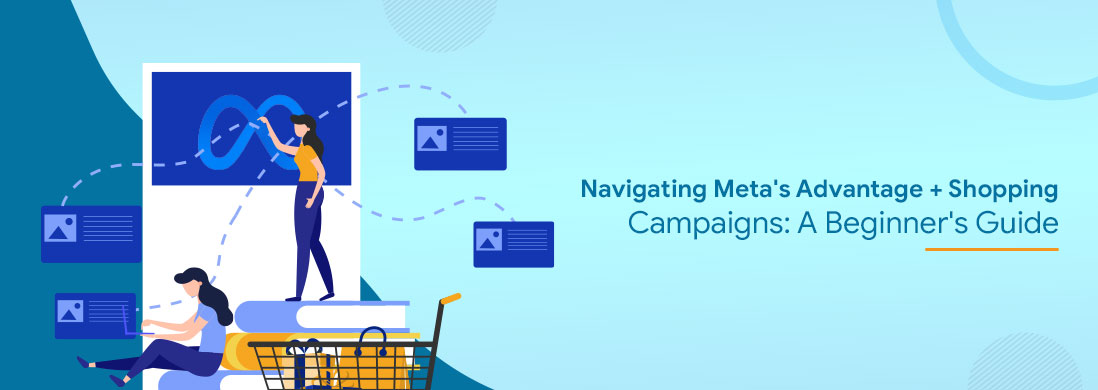The future of tech is shifting towards becoming more Privacy-centric. It is evident from Apple’s actions post-launch of iOS 14, where the users are able to opt out of in-app ad tracking and perhaps have more control over the data they share publicly.
Consequently, the targeting options for Facebook ads will also be limited, resulting in fewer opportunities for campaign managers to conduct granular targeting of iOS users. This, in turn, will lead to a reduction in content personalization, causing businesses to worry about lower returns on investment and higher advertising costs as a percentage of their spending.
In response to this issue, Meta launched ” Advantage+ Shopping Campaigns” ads that leverage AI (Artificial Intelligence) and automation to maximize marketing returns.
Advantage+ Shopping Campaigns simplifies the process of launching and managing shopping campaigns on Facebook, allowing the campaign manager to make more informed decisions with less time spent on mundane tasks
How do Advantage+ Shopping campaigns make advertisers more efficient?
In Facebook managers, Shopping ads advertise specific products from a website using dynamic product feeds. This type of feed is an inventory of all the products or services, specially designed for e-commerce clients as it automates the ad-creation process and allows up to 150 creative combinations at a time.
Previously. advertisers had to manually create and test different targeting options for the audience, platform, placement, and creative format.
However, the new Advantage+Shopping Campaign combines full-funnel marketing approaches into a single campaign, thereby eliminating many manual campaign creation steps.
Thus Advantage+ Shopping campaign helps in reaching more targetted audiences with greater efficiency. Moreover, to optimize conversions, the campaign adjusts and automates settings at every level – from budget and targeting to placements and creatives.
How to Set Up Advantage+ Shopping in Facebook-Ads Manager UI?
Step-1
Choose the ‘Sales’ objective type in the new Meta interface. In the case of the old interface, the ‘Conversion’ objective needs to be selected.
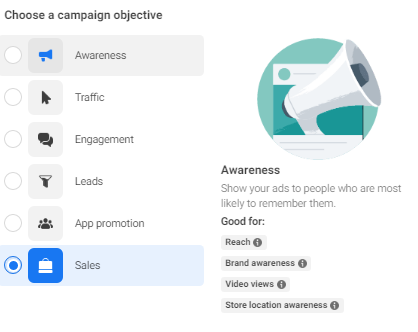
Step-2
After selecting the ‘Sales’ objective, Meta will provide two campaign setup options:-
- Create a manual Sales campaign
- Create Advantage+ Shopping (automated campaign). Select this option and hit Continue.
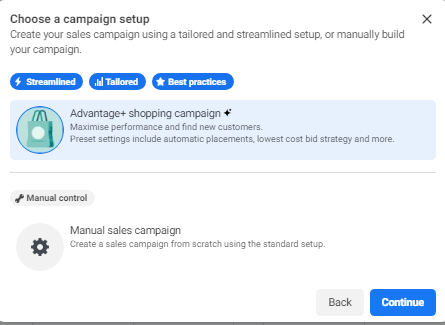
Step-3
Advantage+ shopping campaign requires limited inputs by the advertiser during the setup.
For the rest, the algorithm itself will take care of targeting, placements, and budget allocation.
In the below screen, you will notice that the campaign was created using these preset inputs. An advertiser can view all preset settings by clicking ‘See all preset settings’.
This is a view-only mode, which means that an advertiser can’t change these preset settings.
In case of required changes in specific settings, an advertiser will have to switch back and create a manual campaign instead.
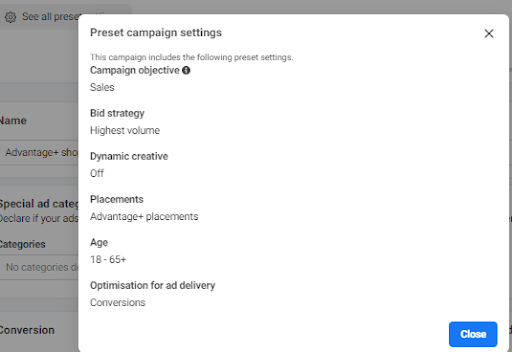
After all the default campaign setup settings are reviewed; an advertiser should name the campaign for quick identification.
Step-4
As, Sales objective is selected; it is necessary to have an active Meta Pixel installed on the website that sends the ‘Purchase’ event. Advantage+ Shopping Campaigns optimize for ‘Purchase’ events by default.
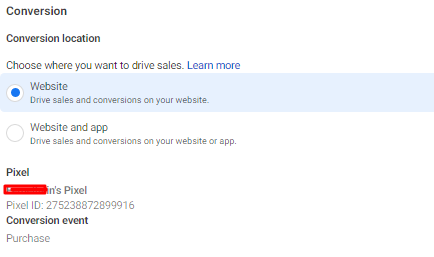
Step-5
In the next phase; one can add the desired location targeting. Only country-level targeting options are available in these campaigns. This is the country where one wants to sell their products. Single or multiple countries can be selected.
Note– In these types of campaigns; advertisers don’t have the option to target other demographics such as age or gender. Targeting by interests is also not an option. Limiting these audience targeting options is Meta intentional as the objective is to provide freedom for the machine algorithm to find as many customers as possible within your targeted location. Alternatively; if an advertiser would narrow the audience by age, gender, or interests, then they would be limiting results

Step-6
In Advantage+ Shopping campaigns; Reporting provides options to receive additional analysis and insights into the campaign. As there are limited targeting controls; an advertiser would still want to know how their existing (custom audiences) vs. new (prospecting audiences) are converting. Some input is needed to break down reports between new and existing customers.
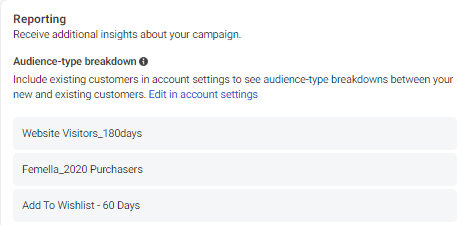
Step-7
To select the Retargeting (existing) audience; Click ‘Go to account settings to open the Ad Account settings page. Or navigate to ‘Ad Account Settings’ from the Business Manager menu.
An advertiser will find a specific section to either create a new custom audience or select from existing custom audiences. All audiences that are added here will be identified as ‘Existing customers’ in the reporting interface of your campaign.
Note As Retargeting audience; an advertiser can add various custom audiences such as customer lists, website visitors, Insta & FB engagers, and Video viewers. One can use whatever list is relevant for your business to report on as ‘existing customers.
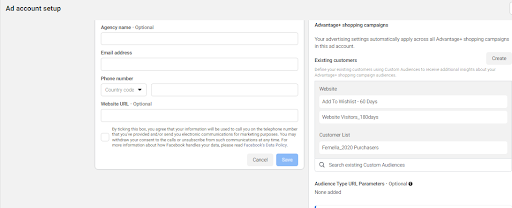
Step-8
Post adding custom audiences for remarketing; an advertiser further can set a budget cap to spend on your existing customers in Advantage+ campaigns.
This option will help an advertiser to control % of the budget that Meta will allocate among new (prospecting) audiences and custom (existing or remarketing) audiences. If the budget cap is not selected; there is a possibility that Meta could be allocating more budget to existing customers instead of finding new customers.
Set your desired ‘Existing Customer Budget Cap’.Note that Meta advises only set a cap if an advertiser needs to prioritize new user acquisition at a lower cost per acquisition.
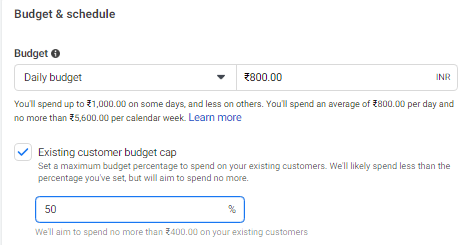
Step-9
After allocating the budgets; the next step is to choose the attribution setting for the campaign. This setting will impact the performance and reporting of campaigns. Because the event manager will use data as per the conversion event and attribution window selected in reporting.
By default; most of the meta ad accounts select the ‘7-day click or 1-day view’ attrition window setting in the campaign. This will maximize the number of signals that Meta can use to optimize your campaign.
On the other hand; If advertisers observe lots of visitors and conversions happening on their website on a daily basis, then they can even consider setting it to ‘click’ only attribution.
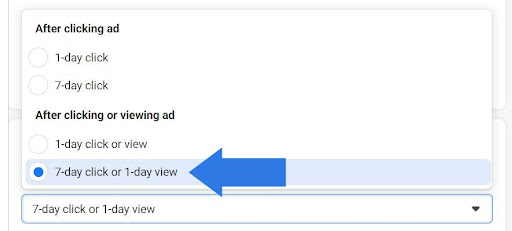
Step-10
Last step after fixing the audience and delivery setting is to create ads by adding some creatives. If an advertiser is the first time creating Advantage+ Shopping campaigns; then Meta will suggest importing ads based on historical data. One can see an overview of suggested ads to import.
Meta’s suggested ads are ads that have proven to generate good conversions at a lower CPA based on historical campaign performance trends. Hence, Meta suggests importing all eligible existing ads so that it can automatically test the creatives and deliver the best-performing ones.
Also, customized ads can be later added at the ad level just like manual shopping campaigns. In advantage+ shopping campaigns; an advertiser can test up to 150 creative combinations in one campaign to deliver the best-performing ads to the highest-value shoppers.
Select the ads you want to import and click Import All Ads
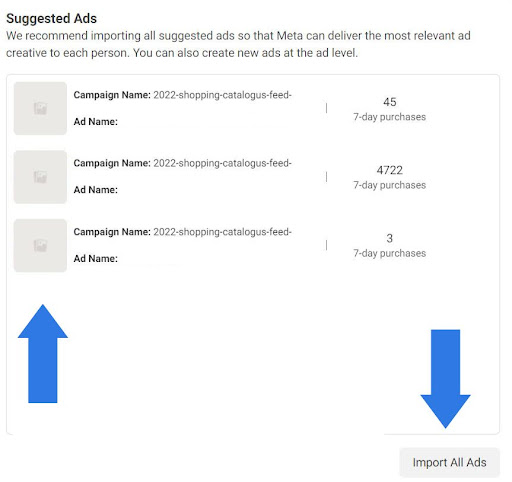
Audience & Geography Performance Breakdown Reporting
Reports help in analyzing the performance with delivery insights. If custom audiences [Retargeting] audiences are used in a campaign setup; an advertiser can get breakdown results by ‘Audience Type’.
This breakdown option allows one to view results by new and existing customers/audiences. This means that an advertiser can know how many purchases came from New customers vs. people in your custom audience segments (Existing customers).
Audience Breakdown report has below three audience reporting:-
- Existing Customers: This column in the report presents total conversions or purchases from audiences that are included in the Custom Audiences and added to your campaign.
- New Customers: This column indicates conversions from people outside your Custom Audiences. [Prospecting audiences]
- Unknown: This column indicates results when the ad was delivered to people while your existing customer segment was still empty. These people may have been new or existing customers.
Note– The conversion reporting attributed to new and existing users is estimated. Existing customers may be mapped to New Customers when they aren’t matched during your custom audience setup. For E.g. Someone purchased from your website in the past, but if the audience isn’t added to a customer list or isn’t included in your website custom audience is due to privacy-related tracking limitations.
Further; when an advertiser is running Advantage+ Shopping Campaigns in multiple countries (E.g. You’ve added both Belgium and Netherlands as targeting countries during the campaign setup.), one can also get a breakdown report by ‘Audience Type and Country’. This way you can easily report on performance by audience type and country.
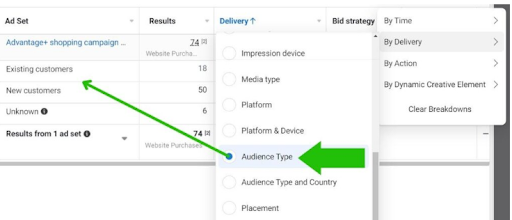
Advantages of Automated Shopping Campaigns-
- Advertisers can use this almost fully automated campaign available to increase conversions at a lower cost per purchase. The campaigns work as per AI/ Algorithm set by Meta.
- The campaign setup is quick and easy. Also; 125 creatives can be used in one campaign and there is no requirement of creating different adset targeting different audiences. But, at the same time an advertiser must be aware of the defaults and monitor closely if that setup works for your business.
- Advertisers already seeing lots of purchase activity will probably benefit more from this campaign type than niche advertisers having smaller budgets to let the AI take over.
Hence; advertisers should start experimenting with this type of campaign today and see how it performs for the business. Also; they should keep analyzing if any manual changes or targeting are required as per the breakdown reports. If there is a hypothesis; that a particular age group or audience is performing better; a separate manual adset should be prepared later. This will help in giving more budget exposure and control on the targeting that is resulting in better conversions at lower cost metrics such as CPA, CPM, or CPC. Also; it seems that in the future Meta will probably expand its automation processes and upgrade new changes in campaigns to further optimize conversions.

